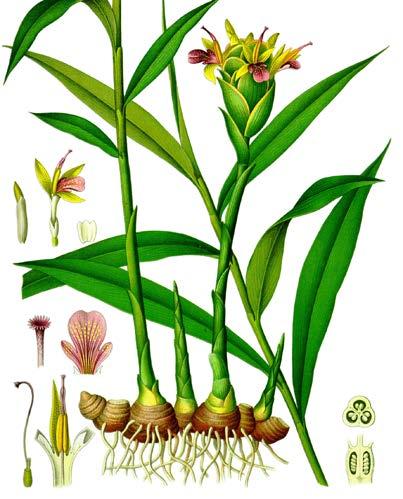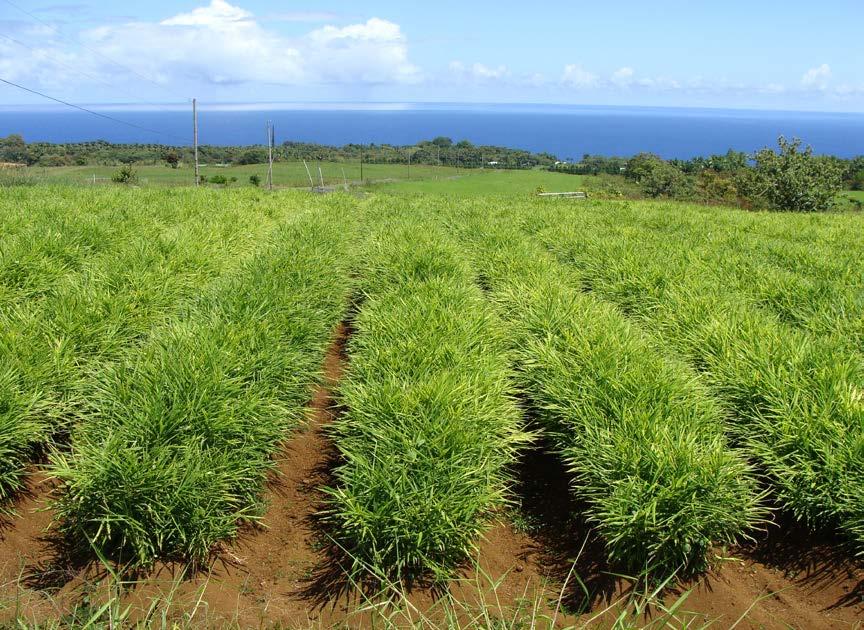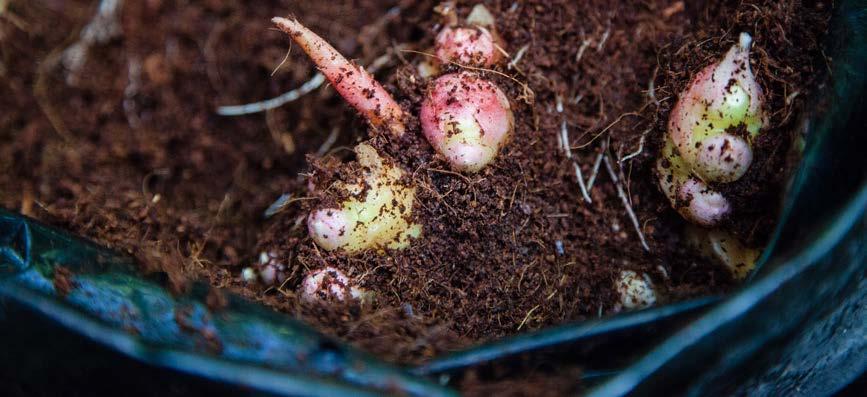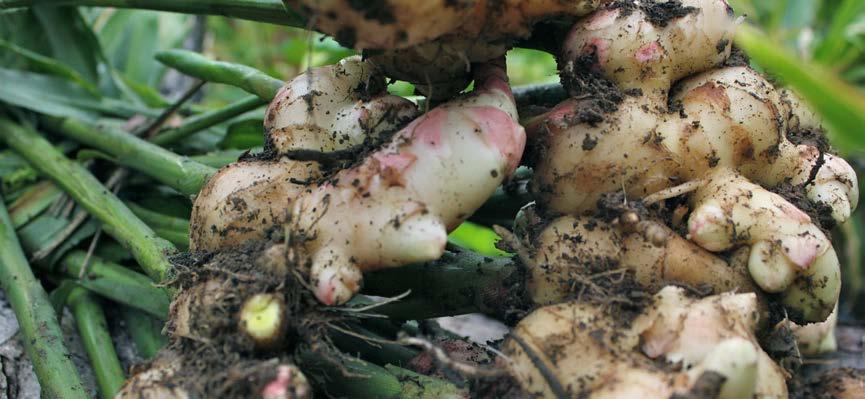
7 minute read
Crop Establishment
Varieties
There are four known varieties of ginger in Jamaica. These are:
Advertisement
The Jamaica Native (Fig. 1) – small, fibrous rhizomes that are very pungent; when cut, they exhibit a rich yellow interior
The blue or flint ginger (Fig. 2) – medium-sized, pungent, fibrous rhizomes which, when cut, exhibit a bluish tinge
The yellow or white ginger (Fig. 3) – medium-sized rhizomes that are less fibrous, pungent; when cut , they have a yellow interior
Hawaiian or Chinese ginger (Fig. 4) – large, plump, fibrous, less pungent rhizomes which, when cut, has a white to cream colour interior with a bluish ring in older rhizomes.
Growth
The ginger plant has three distinct growth phases. The first phase involves root and shoot development, which occurs within 35 to 45 days after planting (DAP). Under ideal conditions, shoots appear aboveground 10-15 DAP, although this process may be prolonged for up to two months.
The second phase vegetative growth, which is followed by flowering, primarily occurs within the next 150 days, with slow rhizome growth. Flowering usually takes place at the end of this phase, at 6 ½ months. The flowers appear white or yellowish-green in colour and are usually sterile, rarely setting seed.
During the next 90 days, shoot leaf growth ceases with rapid rhizome growth; this is the third phase. By 8 months, the shoots typically dry down. Mature rhizomes are usually harvested 8 to 9 months after planting.
Photoperiod plays an important role in the development of ginger rhizomes. Ginger plants may require either short or long day length periods for its growth. As day length is increased from 10 to 13 hours, vegetative growth is enhanced. Vegetative growth is inhibited and rhizome swelling promoted as day length decreases from 13 to 10 hours.
Climate and soil requirements
Ginger is best adapted to warm (29°-32°C) and humid climates for growth. The base temperature requirement is 13°C, with an upper limit of 32°C/27°C day/night temperatures. Temperatures in excess of 32°C can cause sunburn, while low temperatures induce dormancy.
Ginger plants require annual rainfall of at least 1,5002,000 mm, with a maximum 3,000 mm per annum, evenly distributed throughout the vegetative stage. In the absence of adequate rainfall, irrigation becomes essential. Ginger also requires one month of no rainfall prior to harvest. Although able to grow at sea level or up to 1,500 metres above it, ginger thrives at an optimum elevation of 300-900 metres.
Ginger grows best in well-drained, light to medium textured soils with a good supply of organic matter and a pH between 5.5 and 6.5. Stiff clays and coarse sands and soils with low pH are unsuitable for the cultivation of ginger, as they tend to cause malformation of the rhizomes and poor growth respectively. In soils with high manganese levels, the pH should be between 6.5 and 7.0. The soil should be high in biological diversity with a good balance of beneficial microorganisms.
Site selection and preparation
The site selected for ginger cultivation may be in full sun or have partial shade not exceeding 45%. Shading is helpful in reducing water loss and aiding in the general cooling of the plant to prevent sunburn. Plants in full sun will require overhead sprinkler irrigation to aid cooling. The soil should have good drainage and aeration, and be tested for nutrient status, pH, and soilborne pathogens, including nematodes, before planting.
Cultivation of ginger on slopes greater than 40 degrees should be avoided, and the best land husbandry practices must be employed. On hillsides, contour mounds are to be made across the slope. The distance between mounds is dependent on the slope of the hill.

These mounds minimize or slow down soil erosion. Contour drains are to be made 10.7 – 12.2m (35-40 ft) apart to facilitate run-off. These drains are to be connected to waterways which will act as catchment areas.
The land should be ploughed to a depth of at least 30 cm (12in.), one to three months before planting, and allowed to weather properly, then be harrowed and furrowed to a refined condition before planting.To avoid water-logging conditions, appropriate drains must be constructed. Approximately 10-15 tonnes of organic manure per hectare should be applied to the soil during land preparation.
Selection of planting material
Rhizomes for planting are selected from disease-free material. It is recommended that second-generation (F2) seed from tissue culture origin be used as planting material. Seed pieces for planting should weigh between 25g and 50g each, having 2-3 good buds.

Pre-plant treatment
The aim of pre-plant treatment of rhizomes is to induce early germination and protect planting material from soilborne pests and diseases. Ginger Rhizome Rot is a serious disease that warrants seed treatment before planting. Hence, seed pieces should be dipped in an appropriate fungicide, such as Dithane M45, Topsin M, or another recommended fungicide, at a temperature of 50°C for 10 minutes to aid in the control of seed-borne pathogens and nematodes. Treated rhizomes are then air-dried in the shade and planted out shortly thereafter.
Planting
Planting is done at the start of the rainy sea son, usually between April and May. On flat land, the normal plant spacing is 23-30 cm x 15-23 cm (9-12 inches x 6-9 inches). This spacing gives 110,000 - 218,000 plants per hectare (44,000-87,000 plants per acre). Sets are placed in furrows 30-45 cm (12-18 inches) deep then covered to a depth of 4-8 cm (1.5-3.0 inches).
On the slope, furrows are planted 80-90 cm (2.5-3.0 ft) apart, along the contour. Sets are placed 20-30 cm (8-12 inches) apart in furrows 30-45 cm (12-18 inches) deep, and covered to a depth of 4-8cm (1.5-3.0 inches).
In small-scale plantings (less than 1 acre), it is recommended that mulching with green manure be applied two to three times during growing season (one at planting, the second at 45DAP and the third 90DAP), as this adds nutrients to the soil. It also assists in controlling weeds and provides desirable conditions for beneficial microorganism activity in the root zone.
Local research has shown that the use of green manure from tree legumes such as Gliricidia sepium can improve yield by 30%.
Fertilizing
Soil analysis is the best way to determine the optimum fertilization regime for the crop. Although ginger is often not fertilized in Jamaica, much higher yields are obtained with fertilization. Ginger is a very nutrientexhaustive crop, hence application of chemical fertilizer/ or organic manure is absolutely essential.
Ginger plants remove up to 90 kg N/A, 40 kg P/A, and 120kg K/A. The incorporation of fertilizer just prior to planting is important in the initial stages of the crop. Pre-plant application may include a complete fertilizer, additional phosphorus, calcium, or straight fertilizers and organic matter. Nitrogen is supplied as a complete fertilizer NPK ratio of 1:3:1 (eg 10:30:10), 1:1:1 (eg 14:14:14) or 1:2:2 (eg. 11-22-22). Three split dosages are made with 20% as a pre-plant application, approximately 30% of the total N is applied during the first three months and the remaining 50% at five to seven months after planting.
Complete fertilizer applications should be made every two to three weeks up to seven months after planting. Fertilization after planting is made as a side-dress application 25-30 cm (10-12 inches) from the plant row, since ginger is susceptible to fertilizer damage. Complete fertilizer applications are stopped at six to seven months DAP when flowering begins. Several applications of a potassium fertilizer such as K-mag (0026) or muriate of potash(0-0-61) are made late in the crop to increase the plumpness of the rhizomes and to produce a shiny skin surface. Micronutrients should be applied as foliar applications of Zn (90.3%) +Fe (0.2%) and Boron (0.2%) at 45 and 75 DAP after planting.
Please note the above recommendations are a guide only, as fertilizer applications should be ultimately guided by the results of a soil test.
Intercropping and Rotations
Intercropping ginger in agroforestry systems such as between rows of coconuts, fruit trees, or rows crops such as pineapples, corn, or beans is encouraged. Compatibility with roots of the intercrop and possible competition for nutrients must be taken into consideration. Hilling of ginger may be problematic in intercrops, hence field arrangements should be amenable to hilling of ginger.
Ginger should not be intercropped with solanaceous crops, including tomatoes and Irish potato, since these crops may contribute to the build-up of soil-borne pathogens such as Ralstonia solanacearum, the causal agent of bacterial wilt in the field. Ginger may be rotated with crops such as corn, scallion, dasheen, or peas.
Intercropping and crop rotation improve nutrient cycles and reduce pest levels.

Weed Management
Pre-emergence herbicide treatment with herbicides such as diuron at 2kg/A can be used to control weeds in the first three months of crop establishment. Later in the growing season, one or more cycles of manual weeding may be needed. This should coincide with the moulding or hilling, about four to five months after planting. It is best to avoid land infested with nutsedge, as this weed is very difficult to remove, and will pierce the rhizome, forming “nuts” inside them. Further, it may even reduce the size and yield in infested parts of a field.
Irrigation
The water requirement of ginger has been estimated to be between 1320-1500mm during a complete crop cycle. In areas receiving less rainfall, the crop will need regular irrigation. Irrigation is given at fortnightly intervals of 10 days at 90-100 mm/ha in 16-18 irrigations.
Crops must receive approximately 10mm of water every two days during the rapid growth phase. Scheduling irrigation at 60mm cumulative pan evaporation and IW/ CPE ratio of 1.0 will produce maximum rhizome yields.
Protected cultivation
Fertigation technology
Protected cultivation systems without soil utilize fertigation technology. In this system, media such as coco peat or coir are used as replacement for soil.

Due to the limited availability of good land to establish ginger, stemming from the large quantities of land currently affected by the rhizome rot disease, this may be a necessary alternative for cultivation of ginger. In this technique, polybags are filled with media, and irrigation and fertilization are done simultaneously via a fertigation system that supplies both directly to the crop roots.
The system is able to reduce the use of fertilizers by supplying fertilizer solution based on each crop’s formulation, while distributing the solution to the crops based on their growth levels and needs. This technology can be automated using a timer, thus reducing the labour associated with these tasks.
This technology is currently used in Jamaica for the production of clean ginger planting material under nursery conditions. The electrical conductivity of the fertigation solution should be between 1.8uS and 2,5uS.
Rain shelter structure
A rain shelter has been designed for use in some countries that are exploring protected cultivation of ginger. This may consist of a side-netted galvanized steel frame measuring 30m by 10m wide by 4.5 m high, with transparent polyethylene film (180um thick), roofing, and an insect-repellant netting (0.1 x 0.1mm) side cladding. The entrance must utilize double doors so as to reduce the entrance of insects.






